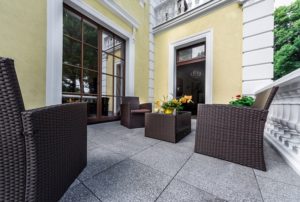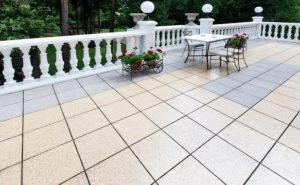The problem of leaks can not only be burdensome for our wallet, but also dangerous
for the health of the household members. What to do to protect yourself from expensive renovation,
and the balcony has successfully served us for years in an unchanged condition?

The first sign of problems with the terrace are loosening, cracking tiles, and the next – damp patches and stains of moisture on the ceiling and walls of the room under the terrace. Such problems are often related to the belief that when laying external cladding, their installation does not have to be as precise as in the case of internal floors. And this is not true.
When the terrace is on the ground
If you want to make a terrace on a natural substrate, a thin layer of gravel should be applied to the waterproof layer. After compacting and leveling it to the desired level, we can start laying the slabs, the joints of which should be filled with special aggregate at the end. When using this method, a very important activity is to remove the soil layer to the depth of a stable, permeable substrate used for water drainage. This will prevent rainwater or thaw from overflowing onto the surfaces adjacent to the terrace, as well as washing away its foundation by large amounts of water penetrating the ground. To obtain an even more durable substrate, you can try to make the surface using the stonemasonry method. If you decide to lay the material on concrete slabs, you should moisten the primer, then apply a layer of cement mortar on it and level it. Then pour the cement laitance and lay the tiles, hammering them off with a rubber mallet. It should be remembered that all of the above methods require welds with a width of min. 5 mm. A terrace protected in this way will drain water quickly and effectively, even during intense and prolonged rainfall.
With a distance to the balcony
The way it is laid is as important as the choice of cladding. On balconies, one of the simplest methods of installation is to lay the slabs on spacers, which level the uneven surface of the substrate and create even joints.  This type is the most convenient – you can start laying it on a watertight layer or concrete screed. You can also use mounting on cement bags, which are placed at the junction of the corners of four boards. It should be remembered that the mortar should have a semi-dry consistency that allows it to support the weight of the cladding. In this case, it is worth using a cross so that the joint between the tiles remains the same width. Until the underlay hardens, any unevenness can be corrected by hammering the tiles with a rubber mallet. With the use of such laying methods, the gaps are left unfilled – rainwater gets into the waterproof layer, where it is drained. A network of small channels instantly removes rainwater from the protective coating, so that the proper surface of the terrace is not exposed to puddles that can lead to its destruction.
This type is the most convenient – you can start laying it on a watertight layer or concrete screed. You can also use mounting on cement bags, which are placed at the junction of the corners of four boards. It should be remembered that the mortar should have a semi-dry consistency that allows it to support the weight of the cladding. In this case, it is worth using a cross so that the joint between the tiles remains the same width. Until the underlay hardens, any unevenness can be corrected by hammering the tiles with a rubber mallet. With the use of such laying methods, the gaps are left unfilled – rainwater gets into the waterproof layer, where it is drained. A network of small channels instantly removes rainwater from the protective coating, so that the proper surface of the terrace is not exposed to puddles that can lead to its destruction.
What else should you absolutely remember? It is also very important what product we use to make a terrace or balcony. Those products that are characterized by low water absorption will certainly better withstand winter, temperature fluctuations or moisture. For the terrace, we should also choose products that are distinguished by a non-slip surface, high frost resistance and an additional, external layer of impregnation.
Author: Probet-Dasag
